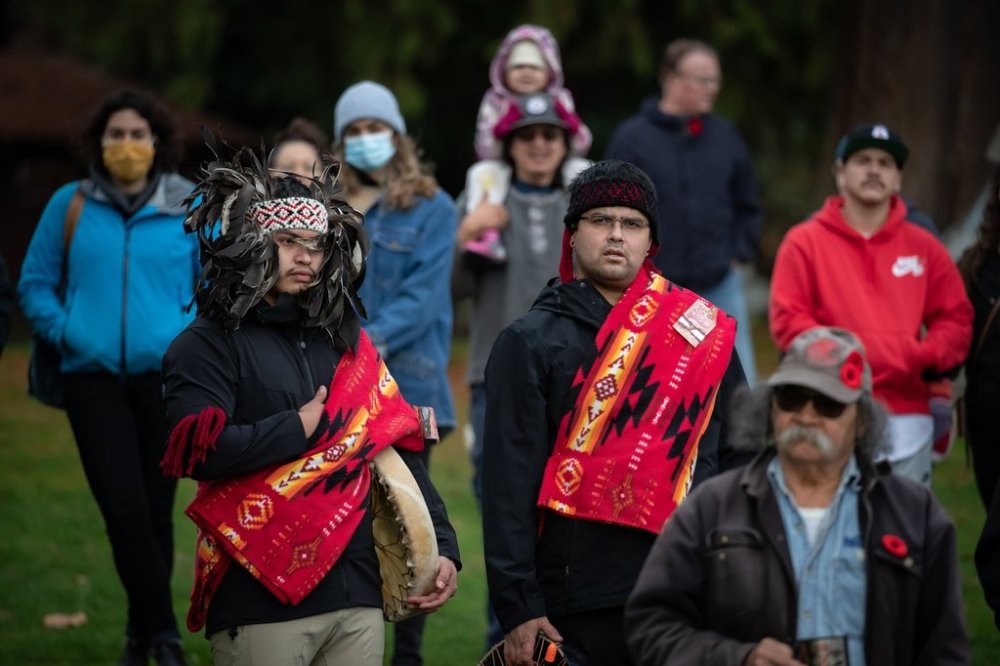Science
Indigenous Veterans Share Unseen Battles of Service and Sacrifice

VANCOUVER – Indigenous veterans in Canada have faced unique challenges both during their military service and upon returning home. John Moses, a member of the Delaware and Upper Mohawk bands from Six Nations of the Grand River, recalls the struggles his father, Russell Moses, faced after returning from the Korean War in 1952. Despite serving his country, Russell encountered racial discrimination, being denied entry to a bar in Hagersville, Ontario, solely due to his Indigenous heritage.
John Moses, who also served in the Canadian Armed Forces, highlighted the irony faced by many Indigenous soldiers. After fighting for the sovereignty of nations abroad, they returned to a Canada where their own civil rights were still not fully recognized. “After having fought abroad for the sovereignty of small nations overseas, they come back to a country within which we still, at that point, did not enjoy the same range of civil and political rights as other Canadians,” he stated.
Indigenous Veterans Day, observed on November 8, aims to honor the contributions of Indigenous soldiers. Historian Scott Sheffield notes that this day grew from grassroots movements in Winnipeg in 1993 to a national recognition, and he describes it as a “logical precursor to Remembrance Day” on November 11. Many wonder why Indigenous people would fight for a country that has marginalized them, but Sheffield explains that motivations varied widely, from adventure to economic necessity, and in some cases, it served as a political statement.
One notable figure, Tommy Prince, one of Canada’s most decorated World War II veterans, exemplified this sentiment. He sought to prove that Indigenous soldiers could stand shoulder to shoulder with their non-Indigenous counterparts. “He served his whole career with that kind of chip on his shoulder to prove himself a superb soldier, which he did in spades,” Sheffield remarked.
While serving often fostered camaraderie and respect among soldiers, Indigenous veterans like Russell Moses found that this acceptance did not persist upon their return home. “They expected that acceptance to continue after the war, to be honest, and that was more disillusioning,” Sheffield noted. Many veterans who had served in World War II chose to enlist again for the Korean War, hoping to regain that sense of belonging.
According to the federal government, more than 4,000 Indigenous individuals served during World War I, with one in three able-bodied men volunteering. In World War II, over 3,000 First Nations people enlisted. However, Sheffield suggests these figures might be understated, as records did not consistently document individuals’ ethnic backgrounds. He estimates that as many as 4,300 Indigenous soldiers may have served in the Second World War.
The government acknowledges the discrimination faced by Indigenous veterans, noting that many believed their sacrifices would improve their rights and standing in Canada. Unfortunately, this has not come to fruition, resulting in lasting social and physical effects for Indigenous veterans and their communities.
In recent years, reconciliation efforts have included initiatives to better recognize Indigenous veterans. The Last Post Fund Indigenous Initiative, established in March 2019, aims to ensure that no veteran is denied a dignified funeral and burial. To date, more than 265 grave markers have been placed, and 24 Indigenous community researchers are working to identify unrecognized veterans’ graves.
Floyd Powder, a researcher with over 32 years of service in the Canadian Armed Forces, is among those identifying graves of Indigenous veterans who lack headstones. He emphasizes the importance of including Indigenous symbols or language on these markers, which can symbolize recognition and honor from Veterans Affairs Canada and the Last Post Fund.
Veterans Affairs Canada has stated that celebrating Indigenous Veterans Day does not detract from Remembrance Day but instead enhances the observance by highlighting the significant history of Indigenous service. Sheffield encourages Canadians to reflect on the mutual respect and camaraderie shared by soldiers from diverse backgrounds, which existed long before formal reconciliation efforts began.
“Those are things maybe we should also take to heart, and that might help us as we’re walking a path of reconciliation and trying to find a way to successfully and respectfully coexist in our country going forward,” Sheffield concluded.
This article was first published on November 8, 2025, by The Canadian Press.
-

 Science3 months ago
Science3 months agoToyoake City Proposes Daily Two-Hour Smartphone Use Limit
-

 Health3 months ago
Health3 months agoB.C. Review Reveals Urgent Need for Rare-Disease Drug Reforms
-

 Top Stories3 months ago
Top Stories3 months agoPedestrian Fatally Injured in Esquimalt Collision on August 14
-

 Technology3 months ago
Technology3 months agoDark Adventure Game “Bye Sweet Carole” Set for October Release
-

 World3 months ago
World3 months agoJimmy Lai’s Defense Challenges Charges Under National Security Law
-

 Lifestyle3 months ago
Lifestyle3 months agoVictoria’s Pop-Up Shop Shines Light on B.C.’s Wolf Cull
-

 Technology3 months ago
Technology3 months agoKonami Revives Iconic Metal Gear Solid Delta Ahead of Release
-

 Technology3 months ago
Technology3 months agoApple Expands Self-Service Repair Program to Canada
-

 Technology3 months ago
Technology3 months agoSnapmaker U1 Color 3D Printer Redefines Speed and Sustainability
-

 Technology3 months ago
Technology3 months agoAION Folding Knife: Redefining EDC Design with Premium Materials
-

 Technology3 months ago
Technology3 months agoSolve Today’s Wordle Challenge: Hints and Answer for August 19
-

 Business3 months ago
Business3 months agoGordon Murray Automotive Unveils S1 LM and Le Mans GTR at Monterey









